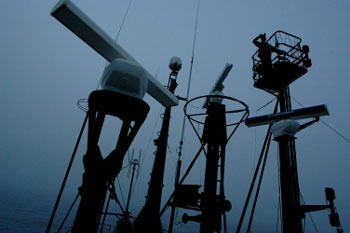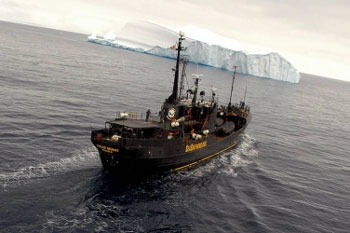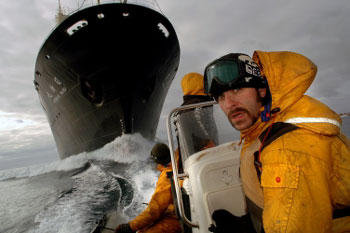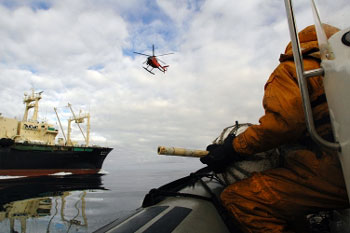The Sea Shepherd Conservation Society vessel Farley Mowat was sailing through the Southern Ocean on a quiet morning when we got the call from the bridge saying that the Nisshin Maru was on the radar and roughly two hours away. The Nisshin Maru is a Japanese factory ship for the illegal whaling industry and the Farley Mowat is the non-profit vessel run by the SSCS, based out of Friday Harbor, Washington state. The Farley Mowat was deployed in the Southern Ocean with a mission to "stop the whaling" even if it meant damaging their own vessel. The SSCS's captain has rammed several vessels at sea and sunk nine other ships in harbors across the world. I had been on board the Farley Mowat for over a month off the coast of Antarctica in the Southern Ocean Whale Sanctuary for a story on SSCS and whaling for my agency, World Picture News.
 |
Radar antennae used for tracking on the SSCS's vessel, the Farley Mowat, in the Southern Ocean. Paul Taggart/World Picture News |
The assignment which was expected to last just one month turned into two months at sea with little communication with the outside world, an all-vegan galley, and a limited amount of booze on board. The small 40-meter (130-foot) all black SSCS ship was outfitted with a pirate flag on the forward mast and 44 crew members on board. This would prove to be one of the more difficult and frustrating assignments I've done. In many ways, Iraq was easier than living on a small ship slammed by gale-force winds of up to 55 knots, pitching and rolling up to 40 degrees for days on end. I found living at the bus station in Maradi, Niger, last fall while covering the famine, harassed by bugs, sweating in the heat and without food preferable to sleeping in my cabin on the Farley Mowat. I was thrown from my tiny top bunk on more than one occasion. The crew was full of passionate and interesting characters but the majority of the two months was little more than waiting: waiting for an action to occur, waiting for the Japanese fleet to show up on the radar and waiting for any type of event to take your mind off of what seemed like a never-ending journey.
On the night of Jan. 7th, Alex (the first mate) made a speech informing the crew to prepare for a confrontation with the mother ship of the Japanese whaling fleet the next morning, including preparations for the possibility of abandoning ship. The crew readied their survival and immersion suits, worked on the Zodiac engines, and inventoried the butyric acid and smoke bombs before going to bed to get a few hours of sleep prior to meeting the Japanese ship.
 |
The Sea Shepherd Conservation Society's vessel, the Farley Mowat, in the Southern Ocean off the coast of Antarctica Paul Taggart/World Picture News |
Early in the morning of the 8th, the helicopter crew took to the air for a reconnaissance flight to visually verify the position of the Japanese fleet just beyond our radar, which could only see 32 nautical miles (about 48 land miles). I waited on the bridge for the return of the helicopter, which was under radio silence. Once the tiny Hughes 300c chopper landed we had confirmation that the fleet ahead consisted of a Japanese factory ship, a few killing ships, and a cargo vessel from Panama as well as two Greenpeace vessels that had been following the fleet themselves in order to document their activities. By 9 a.m. the crew was ready and I was in my wet suit and survival gear, hopping into the lead Zodiac raft along with three SSCS crewmembers that were in charge of fouling the props of the mother ship, the Nisshin Maru. If the Zodiac crew were successful with their prop-fouling devices, the factory ship would be dead in the water and susceptible to a ramming by the Farley Mowat. It was essential that the Zodiac boats be deployed early on since their base speed was 25+ knots while the factory ship could cruise at 17 knots and the Farley Mowat maxed out at only 11 knots. If the Zodiac crew were unsuccessful in fatally damaging the Nisshin Maru, it would be impossible for the Farley Mowat to catch up to the ship in order to conduct more serious actions, such as ramming the SSCS vessel up the spillway of the factory ship.
As I jumped off the Farley Mowat and into our small Zodiac along with the three crewmembers, I checked my gear and the survival pack of essentials that I had packed three weeks prior, waiting for this day to come. I had been at sea for nearly a month with little to photograph as far as actions and whaling were concerned and was becoming increasingly worried that this trip was not going to produce a publishable feature story if the considerably slower Farley Mowat could not catch up to the Japanese fleet. While the crewmembers were excited and nervous, I was finally relaxed and ready to work after a month of waiting.
 |
Crew members from the Sea Shepherd Conservation Society (SSCS) conduct prop-fouling actions in their Zodiac craft, attempting to damage the props of the Nisshin Maru, a Japanese factory ship for whaling in the Southern Ocean Whale Sanctuary, on Jan. 8, 2006. Paul Taggart/World Picture News |
Our Zodiac sped through the sea and quickly approached the Nisshin Maru, which was dead in the water and attached to a cargo ship. As we approached, the two ships separated and we came across their bow as they powered up engines to escape the Farley Mowat. We were greeted by the Nisshin Maru playing a pre-recorded audiotape over their loud speakers, warning the crew onboard the Zodiac to cease their activities or defensive actions would be taken against our small boat. The crew ignored the warnings from the ship and prepared to deploy their homemade prop-fouling devices which consisted of a steel cable with buoys attached at either end along with large pieces of angle iron. The goal was to deploy the first buoy on the starboard side of the Nisshin Maru, cut across the bow and drop the second buoy and hope that the metal cable would drag across the bottom of the hull and into the propeller blades, halting the boat.
The concept alone is ridiculous: chasing a 130-meter (426-foot), 8,030-ton, 17-knot ship with a Zodiac inflatable boat cutting across its bow while it's plowing through the waters trying to escape the Farley Mowat. The three crewmembers valiantly attempted their David and Goliath mission over a dozen times while we weaved through the Japanese water canons and cruised under the enormous bow of the ship. When we crossed the bow the Zodiac pilot cut so close to the ship that when I looked up, all I could see was the bow of the ship completely blocking the sky. After nearly an hour of attempted propeller fouling, the SSCS helicopter pilot flew over and gave us the signal to return to the Farley Mowat.
 |
Crew members from the Sea Shepherd Conservation Society (SSCS) in their inflatable Zodiac craft attempt to damage the props of a Japanese factory ship. Paul Taggart/World Picture News |
Returning to the ship, we swung by the Greenpeace vessel, the Esperanza, and were greeted with friendly waves from her crew. We returned to the Farley Mowat where we found the crew frustrated from the failure to complete their larger mission. With over a month of anticipation leading up to just a few hours of direct action, no props were fouled but by the end of the day the crew realized that they had sent the Japanese fleet running at full speed and kept them from whaling for at least 15 days.
Having reconsidered the encounter as a successful action, the officers of the Farley Mowat decided to set a course for Cape Town, South Africa, since the ship was rapidly running out of fuel and was potentially going to need a tanker sent for refueling. On the night of the 10th, two days after the confrontation with the Nisshin Maru, the ship was left with 41 tons of fuel and the course to the African coast would take 37 tons, leaving us with little room for error or bad weather. The chief engineer turned off the heat in the cabins, restricted hot water usage in the showers and adjusted the engine for fuel efficiency in hopes of making it to land. Cruising at 9 knots and 3-4 knots in rough waters, it took us over two weeks to make it to Cape Town harbor, where the ship was briefly detained in port and the crew classified as illegal foreigners.
After an overnight stay at the dock that the locals refer to as the graveyard, immigration cleared the crew to disembark the ship. We fled the boat like rats thrilled to be on solid ground again after two months of never leaving the confines of the ship. I was thrilled to be in Cape Town and off the ship and in spite of the tiny cabin, vegan galley, and no booze, I'm going to miss the little black pirate ship.
Paul Taggart is a photojournalist based out of New York City. Recent assignments have taken him to Indonesia, Nigeria, Niger, and Liberia. Taggart's work has appeared in The Daily Telegraph, The Sunday Telegraph, The Independent, Boston Globe, Harpers & Queen, U.S. News and World Report, The International Herald Tribune and The Times of London. He is represented by World Picture News.
Visit Paul Taggart's Web site at www.paultaggart.com. For more information on the Sea Shepherd Conservation Society's work see www.seashepherd.org.







